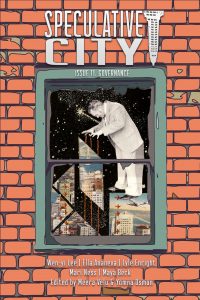Liz Bourke Reviews The Hurricane Wars by Thea Guanzon
 The Hurricane Wars, Thea Guanzon. (HarperVoyager US 978-0-06-327727-4, $30.00, 480pp, hc) October 2023.
The Hurricane Wars, Thea Guanzon. (HarperVoyager US 978-0-06-327727-4, $30.00, 480pp, hc) October 2023.
Hate is another kind of passion. This is a truism repeated by the characters of The Hurricane Wars, Thea Guanzon’s debut novel, and it might go some way towards explaining why the central relationship of the novel leaves me cold: I’ve always found hatred to be a rather chilly emotion, not passionate at all.
The Hurricane Wars is an enemies-to-lovers romance-driven fantasy. The fantastical elements of its worldbuilding are vividly interesting, and some of the nonromantic elements of character and relationship show promise. But the central relationship of romantic (sexual) attraction arising from furious violence and mutual loathing is one that I find difficult to understand, and even more difficult to believe.
For ten years, the Sardovian Allfold has been at war with the Night Empire of Kesath. The Night Empire has the advantage in stormships – flying vessels powered by magic and bristling with arma ments – in troops, and in the powers and training of the Shadowforged Legion, whose members draw on the energies of the dimension known as the Shadowgate. Nineteen-year-old Talasyn has fought for Sardovia for five years as a small flying-ship pilot. An unwanted orphan, or so she thinks, she grew up fighting to survive on the streets until the destruction of her hometown. The leader of the Sardovian forces took her under her wing, because Talasyn has a Lightweaver’s power. Emperor Gaheris has eradicated all the other Lightweavers in Sardovia and Kesath, in part from revenge and in part from ideology, but a Lightweaver’s powers, if properly trained, could match one of the Shadowforged.
But Sardovia is losing. On the battlefield, Talasyn encounters Gaheris’s heir, the commander of the Shadowforged Legion, Prince Alaric. He immediately feels drawn to her, and lets her escape. Later he pursues Talasyn when she has a secret mission to isolated, powerful Nenavar, and they clash again in mutually antagonistic fascination. This mission is also where Talasyn is recognised as Nenavar’s long-lost heir, before she escapes back to her losing war – where she and Alaric clash one more time on the war’s final battlefield, and Alaric saves her life and lets her go.
The ideology behind the war, and behind the Shadowforged Legion’s loyalty to Gaheris, is touched on only lightly. I might have found later developments between Alaric and Talasyn more engaging (or more believable) had the reasons behind their (and their respective nations’) mutual enmity been treated in more depth. Enemies-to-lovers romances have a high bar to clear for me. If there’s a good reason for enmity, the development of affection, if not pure sexual-thrill attraction, is a hard sell; but on the other hand, if there is no good, well-grounded reason for enmity, then a significant part of the narrative – and most of the obstacles to a relationship between the protagonists – can make little sense.
With the war lost and surrender imminent, Talasyn escapes with the remnants of the Sardovian military (the ones who don’t want to surrender) and parleys her status as Nenavar’s lost heir into temporary safety for those remnants. Unfortunately for Talasyn, heirs have responsibilities that junior soldiers do not. When Kesath threatens invasion, Talasyn’s royal grandmother negotiates for her marriage to Alaric and for Alaric and Talasyn’s combined assistance to face a looming natural-magical disaster. Together, the combined powers of Lightweaver and Shadowforged might avert terrible destruction. If they can cooperate, and if Alaric’s father’s obsession with the end of the Lightweavers doesn’t get in the way. But The Hurricane Wars ends before Talasyn and Alaric must decide to either properly cooperate with or properly betray each other, after a nuptial night of antagonistic and explicit passion that settles nothing between them save that they do, in fact, find each other attractive.
Guanzon’s worldbuilding in terms of magic and military technology is interesting, and Nenavar and its court comes across as a vivid place with a culture and court politics extending beyond Talasyn. Unfortunately, after the war is lost in the first few chapters, The Hurricane Wars never regains the sense of tension and urgency present at its opening: the long, drawn out marriage negotiations between Nenavar and Kesath and Talasyn and Alaric’s perhaps predictable ‘‘I hate you but you’re hot!’’ interactions make the latter half of the novel feel stagnant, a sense of stasis made worse by the absence of any narrative catharsis at the novel’s conclusion: forward progress on the nonromantic plot must wait for the sequel. The climax here is a sexual one, focused on Talasyn and Alaric’s eyes-meet-across-the-battlefield chemistry. They want to like each other. They enjoy having sex despite hating and distrusting each other. This may work very well for other readers, but it is so far foreign to my experience of attraction that I can only find it baffling.
The Hurricane Wars has lost heir plots, magical gifts, and at least initially, the drama and tragedy of a losing war. If Thea Guanzon writes a fantasy novel with a different interpersonal focus, I’ll be interested to read it. In the meanwhile, I hope this book finds its intended audience.
Liz Bourke is a cranky queer person who reads books. She holds a Ph.D in Classics from Trinity College, Dublin. Her first book, Sleeping With Monsters, a collection of reviews and criticism, is out now from Aqueduct Press. Find her at her blog, her Patreon, or Twitter. She supports the work of the Irish Refugee Council and the Abortion Rights Campaign.
This review and more like it in the November 2023 issue of Locus.
 While you are here, please take a moment to support Locus with a one-time or recurring donation. We rely on reader donations to keep the magazine and site going, and would like to keep the site paywall free, but WE NEED YOUR FINANCIAL SUPPORT to continue quality coverage of the science fiction and fantasy field.
While you are here, please take a moment to support Locus with a one-time or recurring donation. We rely on reader donations to keep the magazine and site going, and would like to keep the site paywall free, but WE NEED YOUR FINANCIAL SUPPORT to continue quality coverage of the science fiction and fantasy field.
©Locus Magazine. Copyrighted material may not be republished without permission of LSFF.







